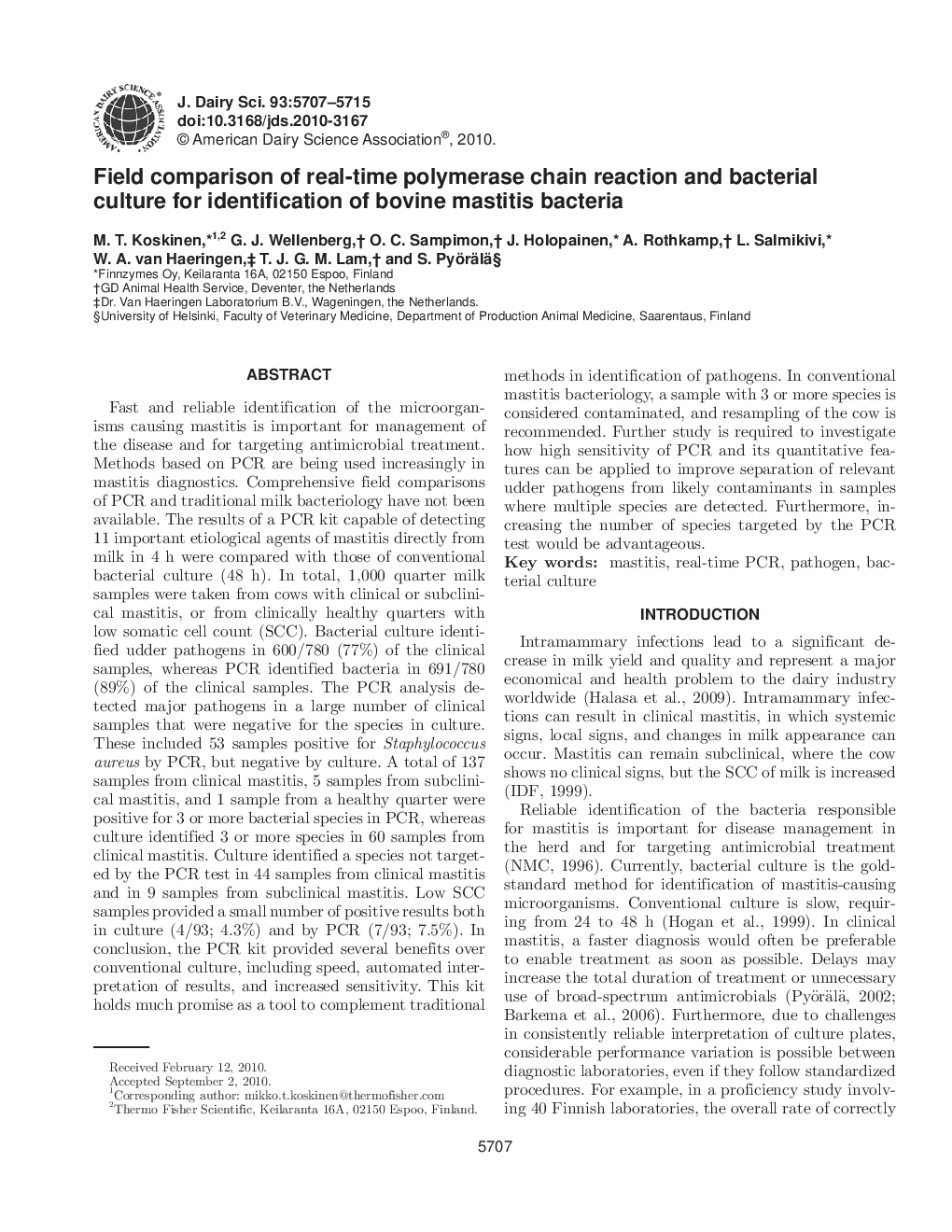| کد مقاله | کد نشریه | سال انتشار | مقاله انگلیسی | نسخه تمام متن |
|---|---|---|---|---|
| 10979178 | 1108062 | 2010 | 9 صفحه PDF | دانلود رایگان |
عنوان انگلیسی مقاله ISI
Field comparison of real-time polymerase chain reaction and bacterial culture for identification of bovine mastitis bacteria
دانلود مقاله + سفارش ترجمه
دانلود مقاله ISI انگلیسی
رایگان برای ایرانیان
کلمات کلیدی
موضوعات مرتبط
علوم زیستی و بیوفناوری
علوم کشاورزی و بیولوژیک
علوم دامی و جانورشناسی
پیش نمایش صفحه اول مقاله

چکیده انگلیسی
Fast and reliable identification of the microorganisms causing mastitis is important for management of the disease and for targeting antimicrobial treatment. Methods based on PCR are being used increasingly in mastitis diagnostics. Comprehensive field comparisons of PCR and traditional milk bacteriology have not been available. The results of a PCR kit capable of detecting 11 important etiological agents of mastitis directly from milk in 4Â h were compared with those of conventional bacterial culture (48Â h). In total, 1,000 quarter milk samples were taken from cows with clinical or subclinical mastitis, or from clinically healthy quarters with low somatic cell count (SCC). Bacterial culture identified udder pathogens in 600/780 (77%) of the clinical samples, whereas PCR identified bacteria in 691/780 (89%) of the clinical samples. The PCR analysis detected major pathogens in a large number of clinical samples that were negative for the species in culture. These included 53 samples positive for Staphylococcus aureus by PCR, but negative by culture. A total of 137 samples from clinical mastitis, 5 samples from subclinical mastitis, and 1 sample from a healthy quarter were positive for 3 or more bacterial species in PCR, whereas culture identified 3 or more species in 60 samples from clinical mastitis. Culture identified a species not targeted by the PCR test in 44 samples from clinical mastitis and in 9 samples from subclinical mastitis. Low SCC samples provided a small number of positive results both in culture (4/93; 4.3%) and by PCR (7/93; 7.5%). In conclusion, the PCR kit provided several benefits over conventional culture, including speed, automated interpretation of results, and increased sensitivity. This kit holds much promise as a tool to complement traditional methods in identification of pathogens. In conventional mastitis bacteriology, a sample with 3 or more species is considered contaminated, and resampling of the cow is recommended. Further study is required to investigate how high sensitivity of PCR and its quantitative features can be applied to improve separation of relevant udder pathogens from likely contaminants in samples where multiple species are detected. Furthermore, increasing the number of species targeted by the PCR test would be advantageous.
ناشر
Database: Elsevier - ScienceDirect (ساینس دایرکت)
Journal: Journal of Dairy Science - Volume 93, Issue 12, December 2010, Pages 5707-5715
Journal: Journal of Dairy Science - Volume 93, Issue 12, December 2010, Pages 5707-5715
نویسندگان
M.T. Koskinen, G.J. Wellenberg, O.C. Sampimon, J. Holopainen, A. Rothkamp, L. Salmikivi, W.A. van Haeringen, T.J.G.M. Lam, S. Pyörälä,